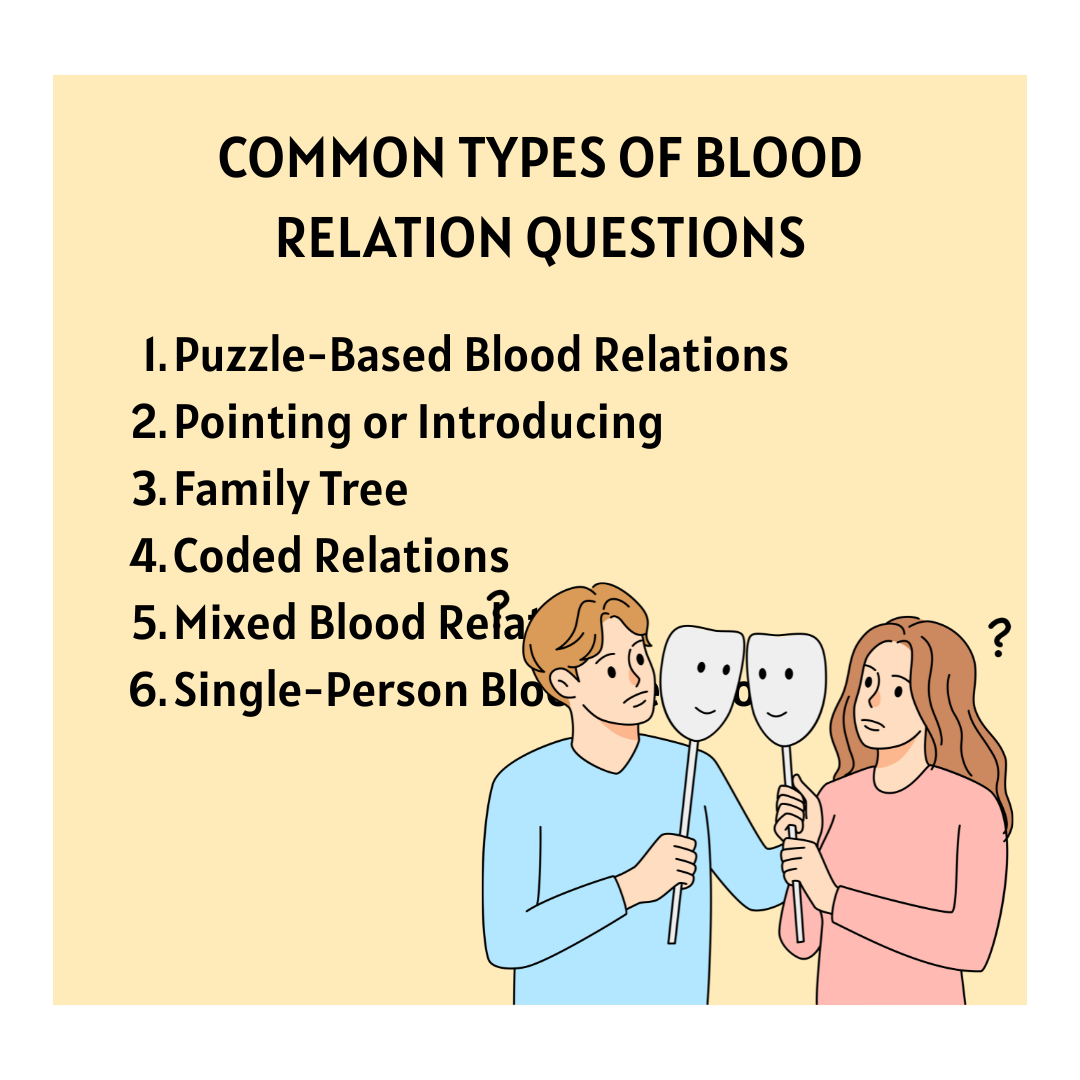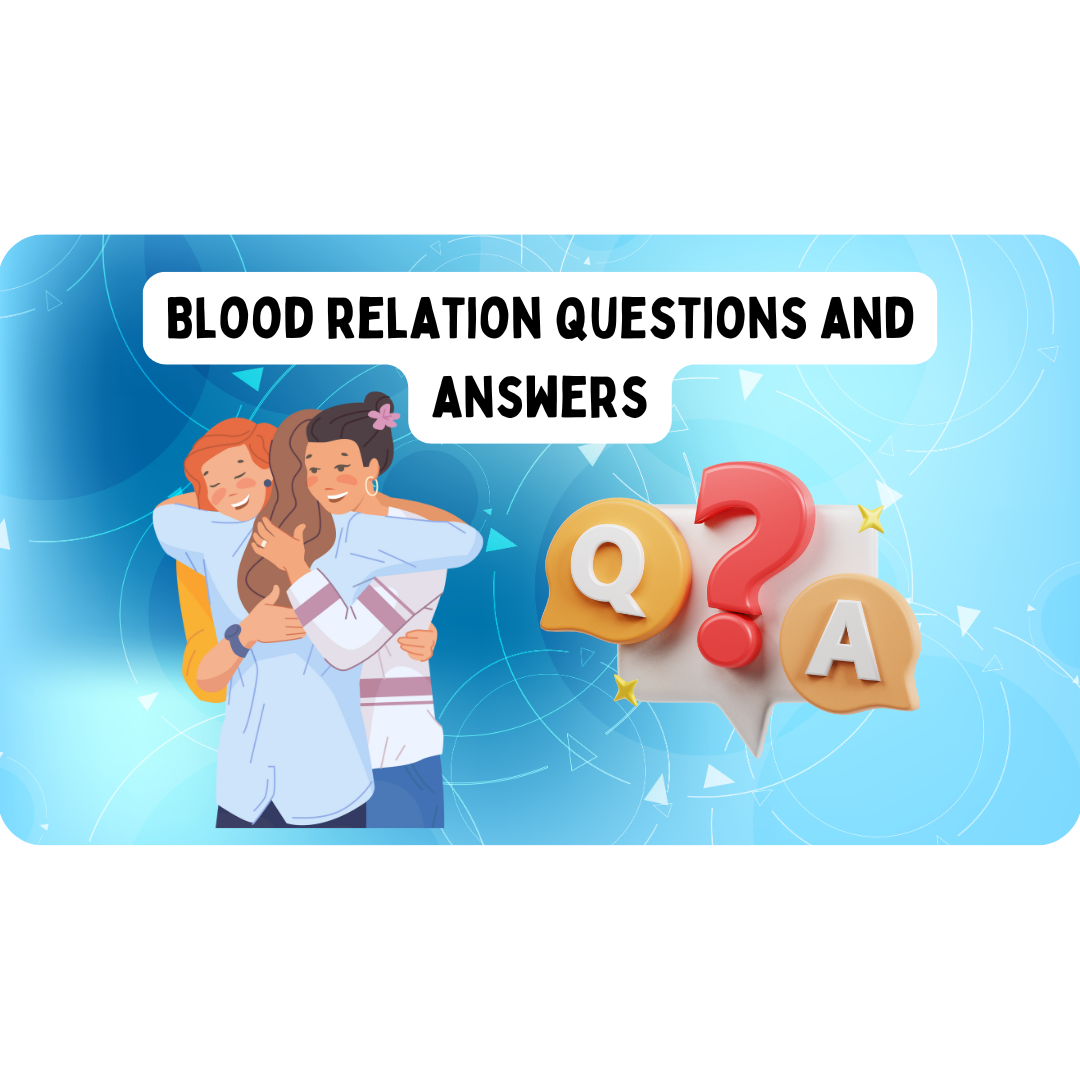Blood relation questions play a key role in the Logical Reasoning section of CLAT. These questions assess your ability to decipher family relationships based on the provided information.
To tackle blood relation reasoning questions for CLAT, it’s essential to have a solid understanding of terms such as sibling, maternal, paternal, and cousin. With consistent practice, students can quickly and accurately solve these questions.
Blood relation reasoning involves interpreting and applying family relationship rules to draw conclusions, usually through direct or coded questions. Success in this area requires a strong understanding of family connections and the ability to make logical deductions.
A blood relation problem, or “Blood Relation Test,” challenges your capacity to reason through the relationships between family members. Similar questions appear in various competitive exams, including SBI PO, Railway Recruitment Board (NTPC), Railway Recruitment Board Assistant Loco Pilot (ALP), IBPS Regional Rural Banks (RRB), and others.
In this article, we’ll explore the different types of blood relation questions commonly found in CLAT, share effective strategies for solving them, and provide practice questions to help you excel in this vital section of the exam.
Common Types of Blood Relation Questions

There are several types of blood relation questions, and each requires a slightly different approach. Here are the most common types you’ll encounter in CLAT reasoning:
-
Puzzle-Based Blood Relations
Puzzle-based blood relation questions present a scenario that involves family relationships. You must use your reasoning skills to determine the family connections.
Example: A family consists of six people across three generations. The grandfather has two sons and one daughter. Each son has two children, and the daughter has one child. How many grandchildren does the grandfather have?
Solution: The answer is 5 (2 children per son + 1 child for the daughter).
-
Pointing or Introducing Relationships
In these questions, a person points to or introduces someone else by describing their relationship. Your task is to identify the exact connection.
Example: A woman refers to a man as “my father’s brother’s son.” How is the man related to her father?
Solution: The man is her cousin.
-
Family Tree-Based Questions
These questions come with a family tree diagram where relationships between family members are visually represented. You need to interpret the diagram and deduce the relationship.
Example: In a family tree, A is the father of B, B is the sister of C, and C is the mother of D. What is the relationship between A and D?
Solution: A is the grandfather of D.
-
Coded Relations
In coded relation questions, family relationships are represented using specific codes. You must decode the symbols or letters to find the relationships.
Example: In a coded system, M stands for Mother, F for Father, S for Son, and D for Daughter. Decode MFS: FMSD.
Solution: The answer would involve understanding each code (e.g., M = Mother, S = Son) and applying logic.
-
Mixed Blood Relations
These questions combine various elements such as puzzles, family trees, and coded relations. They test your ability to handle complex situations.
Example: A man looks at a woman and says, “Her mother’s brother is my mother’s father’s only son.” How is the woman’s mother related to the man?
Solution: The woman’s mother is his aunt.
-
Single-Person Blood Relations
These questions focus on determining the relationship between two individuals based on the given information.
Example: A woman says, “My brother’s son’s sister is my niece.” What is the relationship between the woman and her niece?
Solution: The relationship is that the woman is the aunt of her niece.
Tips for Solving Blood Relation Reasoning Questions
Here are some strategies to help you effectively solve blood relation reasoning questions:
Tip 1: Relate the Given Information to Personal Relationships
Try connecting the relationships in the question to the family dynamics you are familiar with. This can help clarify the logic and simplify the problem-solving process.
Tip 2: Treat “Me” as the Speaker
This is particularly useful when individuals are introduced relative to the speaker. By imagining yourself as the speaker, you can easily work out the relationships between the people mentioned.
Tip 3: Use Visual Aids
Drawing family trees or diagrams can help you visualize relationships. This method organizes the information and provides a clearer view, making it easier to solve the problem.
Tip 4: Focus on the Two Key Individuals
Determine the two individuals whose relationship you need to establish. Then, analyze the connections of other family members to these two and deduce their relationship.
Tip 5: Avoid Gender Assumptions
Never assume someone’s gender based on their name unless it is explicitly stated in the question. Always rely on the provided information to prevent making incorrect conclusions.
Tip 6: Analyze All Options Carefully in Coded Relations
When solving coded blood relation problems, evaluate all the options, including gender possibilities. Eliminate those that contradict the information given to identify the correct relationship.
Tip 7: Understand the Terms “Only Son” or “Only Daughter”
Remember that “only son” or “only daughter” doesn’t necessarily mean there are no other siblings. It only means the individual doesn’t have any other siblings of the same gender.
With consistent practice and exposure to various types of blood relation problems, you’ll improve your logical reasoning skills and become more efficient at solving these questions.
Family Relationship Terminology
- Granddaughter’s or Grandson’s Son: Great-grandson
- Wife’s or Husband’s Brother: Brother-in-law
- Brother’s Daughter: Niece
- Son’s Wife: Daughter-in-law
- Brother’s Son: Nephew
- Mother’s or Father’s Father: Grandfather
- Son of Mother or Father: Myself / My Brother
- Wife’s or Husband’s Sister: Sister-in-law
- Uncle’s or Aunt’s Son/Daughter: Cousin
- Granddaughter’s or Grandson’s Daughter: Great-granddaughter
- Father’s Brother: Paternal Uncle
- Daughter of Mother or Father: Myself / My Sister
- Mother’s Brother: Maternal Uncle
- Mother’s or Father’s Mother: Grandmother
- Daughter’s Husband: Son-in-law
Family Tree Representation
| Element | Representation |
| Female Family Members | Circles |
| Male Family Members | Squares |
| Relationships between Family Members | Double-headed arrows |
| Spouse Relationship | Double lines |
| Generational Arrangement | Each generation is on the same horizontal level |
| Vertical Arrangement | Older generations are at the top; younger generations at the bottom |
Blood Relation Questions for CLAT 2025 (Sample)
Ryan is married to Mia. Mia’s sister is Zoe, and Zoe has a daughter named Ava. How is Ryan related to Ava?
- a) Uncle
- b) Father
- c) Cousin
- d) Brother-in-law
Answer: a) Uncle
Ethan’s mother is Grace, and Grace’s father is William. What is William’s relationship to Ethan?
- a) Father
- b) Grandfather
- c) Uncle
- d) Cousin
Answer: b) Grandfather
Jack’s father is Robert, and Robert’s brother is David. David’s son is Harry. What is Jack’s relationship with Harry?
- a) Cousin
- b) Brother
- c) Uncle
- d) Nephew
Answer: a) Cousin
Sarah’s mother is Olivia, and Olivia’s brother is James. James has a daughter named Emily. How is Sarah related to Emily?
- a) Sister
- b) Cousin
- c) Aunt
- d) Niece
Answer: b) Cousin
Kate is married to Daniel. Daniel’s sister is Claire, and Claire has a son named Max. How is Kate related to Max?
- a) Aunt
- b) Cousin
- c) Niece
- d) Grandmother
Answer: a) Aunt
If X is the sister of Y, and Y is the son of Z, how is X related to Z?
- a) Daughter
- b) Sister
- c) Mother
- d) Aunt
Answer: a) Daughter
George is the father of Lily, and Lily is the mother of Noah. How is George related to Noah?
- a) Grandfather
- b) Uncle
- c) Cousin
- d) Father
Answer: a) Grandfather
Lucas’s sister is Anna, and Anna’s husband is Peter. Peter has a daughter named Sophie. How is Lucas related to Sophie?
- a) Uncle
- b) Cousin
- c) Grandfather
- d) Brother-in-law
Answer: a) Uncle
Mark is married to Julia. Julia’s brother is Tom, and Tom’s son is Charlie. How is Mark related to Charlie?
- a) Uncle
- b) Father
- c) Brother-in-law
- d) Nephew
Answer: a) Uncle
Adam’s wife is Chloe. Chloe’s brother is Ben, and Ben’s daughter is Lily. How is Adam related to Lily?
- a) Uncle
- b) Cousin
- c) Father
- d) Brother-in-law
Answer: a) Uncle
Conclusion
Mastering blood relation questions requires practice, logic, and familiarity with family terms and relationships. By following the strategies in this guide and practicing regularly, you’ll be able to approach these questions with confidence and excel in the CLAT 2025 exam.
For more practice and tips on logical reasoning, check out our Complete Guide to Logical Reasoning for CLAT.
To Download Monthly Current Affairs PDF Click here
Click here to get a free demo
Discover all about CLAT Exam
